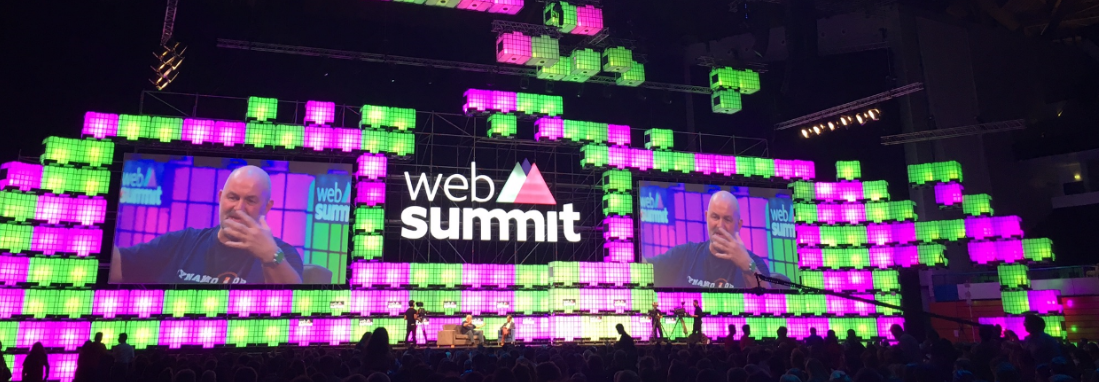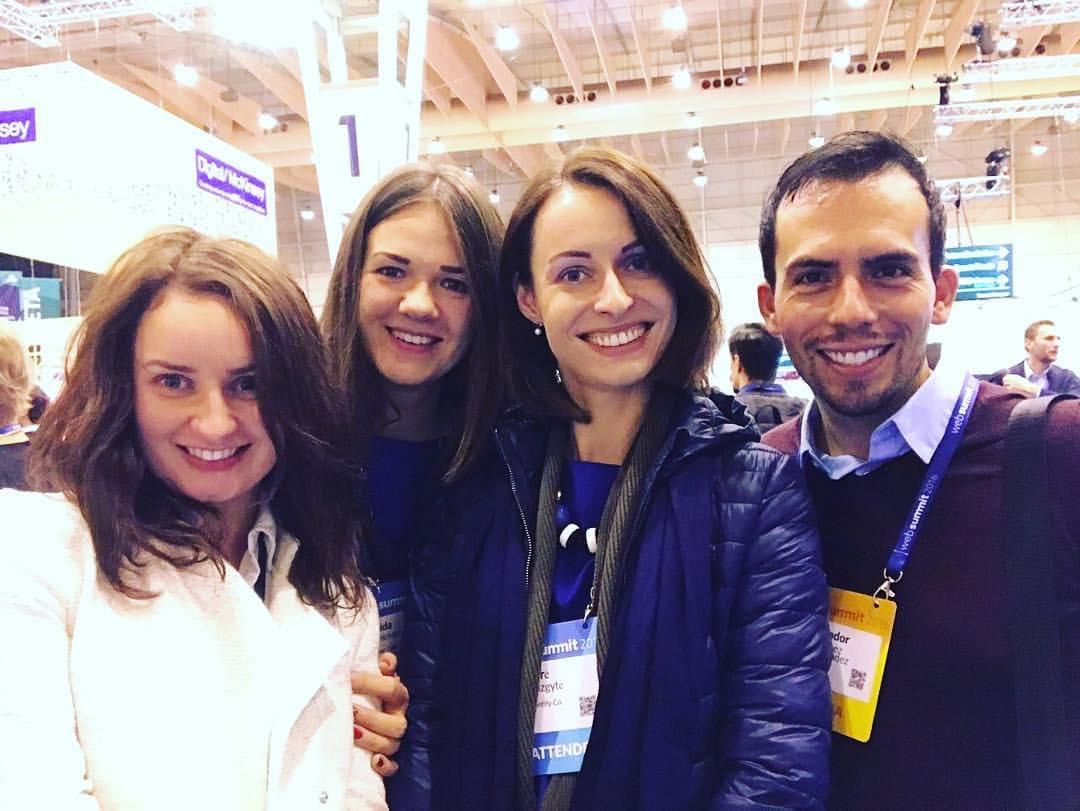Web Summit 2016: A Brief Glimpse Into The Future
2016
Nov 22
Nov 22

Egle Tumenaite from Corner Case Tech was among a dozen of Lithuanians who visited Web Summit 2016 in Lisbon – one of the largest tech and startup events in Europe. She shared her impressions from the events with our readers.
Web Summit, one of the world’s best tech conferences, sometimes referred to as “Glastonbury for geeks” this year attracted over 50, 000 attendees from 166 countries. This year was special not only because they managed to bring the record number of attendees in Web Summit history but also because of a new host city – Lisbon.
C. Hyde from Bloomberg compared Lisbon to European San Francisco. During the opening of Web Summit 2016, Dep Prime Minister of Portugal Paulo Portas validated the comparison. Mr Paulo noted that in addition to the iconic bridge, sun, trams, bronzed surfers, Lisbon has a lot to offer including great facilities, vibrant nightlife and attractive prices.
Corner Case Technologies, a company that builds and grows IT products, was one of the few Lithuanian companies that went to Lisbon for a 3 day long conference. CCT representatives connected with other techies and learned about the future prospects in tech world. CCT team shares their insights and describes the main take-away from talks.
One of the major topics that were touched by key speakers at Web Summit, was the future, empowered by technology. Artificial intelligence, virtual reality, machine learning, robotics, digitalisation were the keywords, that are now being mentioned everyday by executives of the biggest and most impactful companies of the planet.

Digitalisation
John Chambers – Executive Chairman at CISCO Systems says that digitalisation of the world began to take off in 2010 and now we’re just going mainstream. Digitalisation in technology terms is about compiling cloud, security, and mobility to get the right information, at the right time, to the right person, and for the machine to make the right decision.
The first generation of the internet comes from the time when President Clinton grasped what it meant to America and announced the internet era. Internet era generated 22 million jobs in the USA and a GDP growth of 30% in 8 years. J. Chambers is confident about seeing the same thing occurring on a global basis starting with countries leading the way, and moving from connecting thousands of devices of the internet (which is what existed when Cisco was founded 30 years ago) to 15 billion today, to 500 billion in 15 years.
John Chambers believes that opportunities far outweigh the challenges. The model that we saw with the internet era that went for 2 decades, produced benefits to about 15% of the world society and businesses in a big way. Now if we become much more inclusive, or even global, the opportunity is to produce benefits can be stretched to a 100%. Countries, cities or companies sometimes fall into the trap of staying and doing businesses in silos instead of breaking those down and focusing on outcomes to the citizens or for their customers.
Let’s take France as example. President F. Hollande had a vision for a digital France 2 years ago. And for France to be a digital country means making an impact on 66 million people, becoming the startup nation in Europe. France for the first 6 months of this year of 2016, was the number 1 country in Europe in terms of venture capital investment and startups. So this is the period that has a chance to disrupt everyone with many positives – longer lives, better healthcare and many more.
Digitalisation, on both – national and company level may result in having very similar goals. One of the world’s biggest companies – Facebook – has very ambitious plans for the future. Facebook has a mission to include people that don’t have access to the internet, to the global conversation.
Facebook’s ambitions for the next 10 years
Mike Schroepfer, CTO at Facebook shared company’s mission for the next 10 years. He grouped them into 3 buckets: (1) connecting billions of people around the world that don’t have access to internet, (2) building truly intelligent machines that can help manage mass information we have online, and (3) have virtual reality that let us experience anything with anyone, anytime.
Connectivity
Schroepfer noted that out of 7.3 billion people around the globe, only 3.2 billion are connected. To bring internet to urban environments, Facebook needs to go to space. Mike represented AKILA – high altitude, long endurance airplane. It’s made of the carbon fiber, powered purely by solar power, has the wingspan of 737, and weighs less than a 1000 pounds. It was designed to fly for months at a time, constellation of these suppose to eventually provide the internet for suburban areas. Rather than laying cables over the ground over long distance, they simply build the backbone in the sky. That’s connectivity.
Virtual Reality
The idea about augmenting your senses and giving you a sense of presence somewhere else has excited humanity for a long time already. And now it’s here – you can walk into a store and buy a VR headset.
VR is now powerful enough to give a very good sense of presence, and it works not only in video games but in the real world too. It allows transporting people to real world experiences. Schroepfer presented Facebook’s new RND (Research and Development) called StandAlone, which aims to bring VR to the masses by creating a technology that does not require a PC, cables, or special rooms.
Artificial Intelligence
There is a massive increase in the amount of data that we can use to train systems. Just on the Facebook networks alone, we’re seeing 2 billion photos shared every single day. Large amount of data sets now can be used to train machines.
According to M. Schroepfer, just like humans, AI can be used not just for knowledge. The same neural nets can be used to answer information and it can also help us create. Style transfer, for instance. Take a source image, and you paint its’ style on any other image you want. It’s a good example of pace of progress of AI. The first paper on this was written in August, 2015. Six months later, the researcher community had a new technique, a thousand times faster. Rapid progress.
Being able to build and train models on a big server, and then take those models and deploy them directly to your pocket. So you can run them wherever you are in real time. That is the exciting future of AI.
Facebook seems to have huge ambitions in innovation and ultimately further nurturing technological impact on a global level. Gary Marcus – CEO, Geometric Intelligence emphasized that once you build an AI solution that works, you can build an infinite number of copies instantaneously. Artificial intelligence can not only revolutionise the way we do things, but also have a massive impact on our jobs.
Future Job Market
Looking back, A. McAfee, Principal Research Scientist at MIT, says that the middle class was a huge achievement for the society. It was built on routine, or physical work, e.g. assembling line worker, or a payroll clerk. Those jobs are gone in the rich world and they are not coming back. The question is how the innovators can figure out new things that they want to involve people in, new ways for people to work at a fast enough rate.
However, there are a lot of things that humans can do better than the machines. For example Siri can follow some things but it won’t give answers for generic questions, nor perform an understanding of relationships and dynamics between several factors. We don’t have AI systems that can do science very well. Robots now are really good at recognizing objects, however some things that come very naturally for human beings, are not so natural for things like domestic robots. We are at least 1 or maybe 2 if not 5 decades away from having some sort of generic intelligence as opposed to very narrow things, says G. Marcus.
The potential for AI is, however, is infinite. A. McAfee brought up an unfortunate accident when Tesla’s auto pilot drove into the side of the white truck and killed the occupant. “That’s undeniably a tragedy, however we need to keep in mind what the appropriate comparison is. There are 30 thousand road fatalities per year in America, most of them due to driver error, distracted driving. Although I agree that automated technologies can’t do everything yet, I am pretty sure that if we automated a lot of driving tomorrow, the death rates would go down.”
In a few more years, when we call up our cable company, or bank or credit card company, the default will be that we’ll talk to a piece of technology. Talking, not pressing button. A. McAfee says that we passed another milestone recently – a deep learning system beat professional humans at accurately transcribing human to human speech.
“Once you build an AI solution that works, you can build an infinite number of copies instantaneously. So maybe it will take 25 years to make a driverless car algorithm but once you have it, you can make an infinite number of copies and driver’s profession can disappear overnight. “ – G. Marcus
Recently Elon Musk, the CEO of Tesla, brought up that robotics are soon to be having the major impact on employment and jobs and this should bring about universal basic income and governments should be providing for people who have been displaced as machines are taking their jobs. It seems inevitable but it may take 20-30 years to roll out systems that will replace most jobs but eventually it is going to happen, says G. Marcus. At that point we may really need universal basic income.
It can be hard to imagine how our lives will look like in the next decade or two. The message, received during the conference, was clear – innovation brings a lot of benefits together with dilemmas for governments, or entrepreneurs to solve.
Thanks a million Egle for your contribution!
